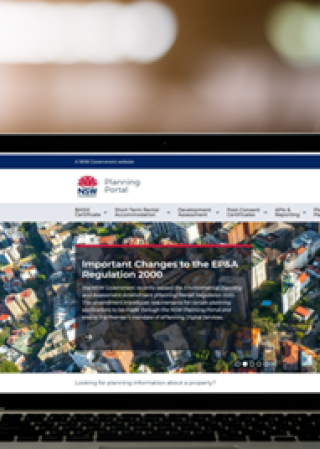From 1 July 2020, changes to the Environmental Planning and Assessment Regulation 2000 (EPA Regulation) required use of the NSW Planning Portal as the central platform for the making of a number of types of applications relating to a development for all but 48 local government areas across NSW.
From 1 July 2021, the transitional provisions ceased to have effect and the requirements to utilise the NSW Planning Portal extended to all councils across NSW.
Marcus Ray, Group Deputy Secretary Planning and Assessment from the Department of Planning, Industry and Environment has estimated that between 1,600 and 1,800 applications are now lodged on the NSW Planning Portal each week.
Following the lodgement of an application, the NSW Planning Portal becomes the means by which requests are made, information is exchanged, referrals are issued and determinations are published. Development applications are allocated a Panel Application Number (PAN) and a profile for the PAN is created on the NSW Planning Portal.
Although introduction of the NSW Planning Portal has provided a centralised platform, there have been a number of unforeseen gaps that have led to uncertainty amongst councils regarding their role and responsibilities in relation to the NSW Planning Portal, particularly when it comes to uploading development consents.
What happens to those development applications which were lodged before the NSW Planning Portal was introduced and do not have a PAN, and have been determined after 1 July 2020 (or after 1 July 2021 for those councils the subject of the transitional provisions) is not clear. Further, councils have queried who is responsible for uploading a determination made by the NSW Land and Environment Court to the NSW Planning Portal.
Section 4.18 of the Environmental Planning and Assessment Act 1979 (EPA Act) confirms that the consent authority must, in accordance with the regulations, notify its determination of a development application to the applicant.
Division 4.2 of the EPA Act sets out the definition of the consent authority, which for the majority of development will be the council. The NSW Land and Environment Court has the functions of the consent authority for the purposes of hearing and determining an appeal, however, it is not a consent authority for the purposes of Section 4.18 of the EPA Act. As such, the responsibility for notifying a determination made by the NSW Land and Environment Court remains with the council.
Clause 102(1) of the EPA Regulation confirms that for the purposes of section 4.18 of the EPA Act the consent authority must:
- “(a) Publish the notice of determination of a development application on the NSW planning portal within 14 days after the date of the determination, and …”
Councils have been experiencing difficulty complying with the requirements of clause 102(1)(a) of the EPA Regulations in circumstances where there is no PAN associated with the development application.
In those circumstances, the Department of Planning, Industry and Environment has provided the following guidance to councils:
To upload Publication for Exhibition:
- 1. Log on to Planning Portal
- 2. Click on New
- 3. Select Publication for Exhibition which will open the below page
- 4. Complete all the required fields and upload the documents.
It is important that councils attend to publishing the notice of determination of a development application on the NSW Planning Portal as soon as final orders made by the Land and Environment Court are handed down, as Court issued conditions specify that the development consent does not take effect until it us uploaded to the NSW Planning Portal.
If you are experiencing any difficulty with the NSW Planning Portal or have any questions about councils role or responsibilities in relation to the NSW Planning Portal, you can contact the Department of Planning, Industry and Environment on 1300 305 695 or by email to info@service.nsw.gov.au.
The contents of this publication are for reference purposes only. This publication does not constitute legal advice and should not be relied upon as legal advice. Specific legal advice should always be sought separately before taking any action based on this publication.


